Are you looking to understand how geologists determine the age and relationships of rock layers across different locations? This guide from rockscapes.net will explore the various methods used to correlate rock layers, helping you understand the Earth’s history. We’ll dive into stratigraphic principles, fossil analysis, and lithological comparisons, giving you the knowledge to appreciate the complexity and beauty of rock formations. Explore the secrets held within Earth’s crust, uncovering geological time scale, biostratigraphic correlation, and chronostratigraphic correlation.
1. What is Stratigraphic Correlation?
Stratigraphic correlation is the process of matching sedimentary rock layers of similar age across geographically separated areas, relying on their sequential relationships. By constructing detailed stratigraphic columns, geologists piece together the geological history of a region. This involves mapping rock formations and describing the layers from the bottom up.
For example, in Utah’s Canyonlands and Zion National Parks, the Navajo Sandstone lies atop the Kayenta Formation, which in turn overlies the Wingate Formation in Canyonlands and the Moenave Formation in Zion. Although the Wingate and Moenave Formations have different names due to slight variations in composition and appearance, their stratigraphic relationship indicates they are correlative. This method allows geologists to trace rock sequences over vast areas, revealing insights into regional geological history.
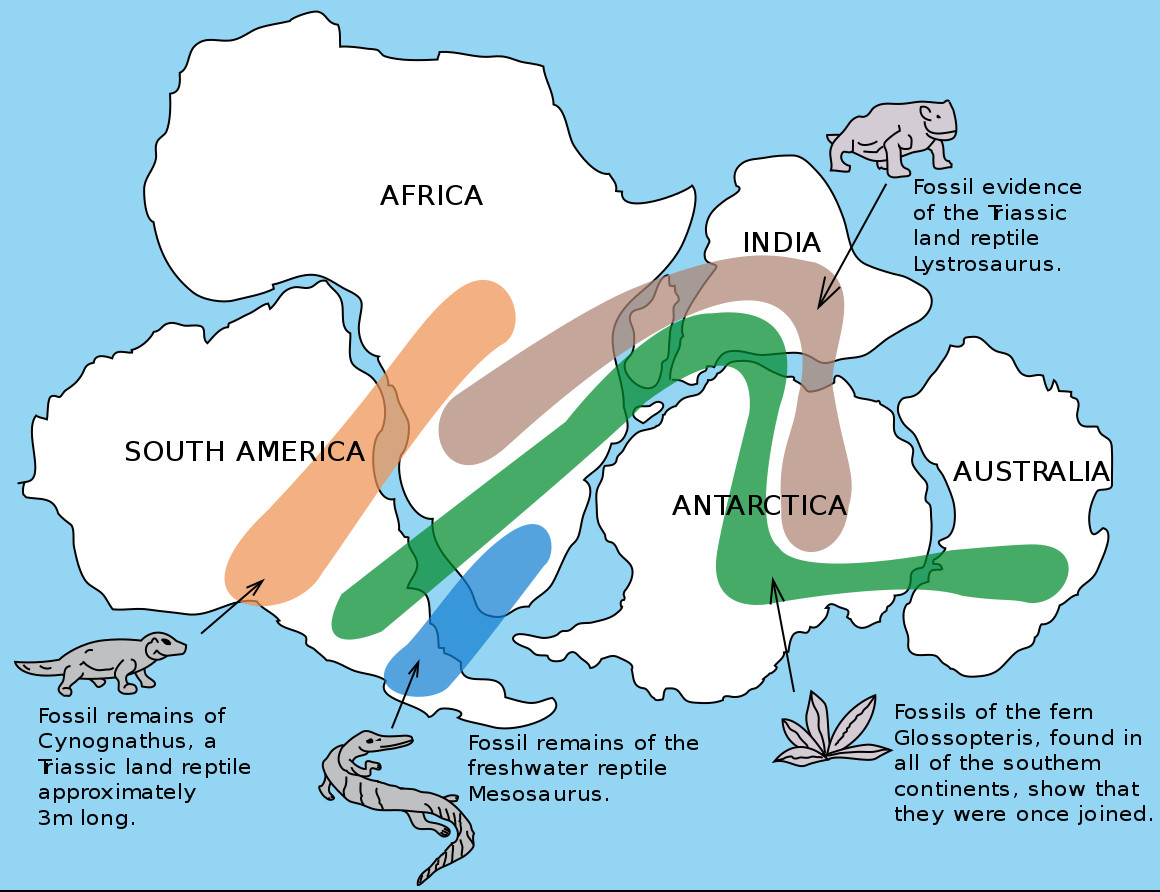 Stratigraphic Correlation Grand Staircase
Stratigraphic Correlation Grand Staircase
Alt text: Stratigraphic correlation of rock layers in the Grand Staircase region, showing relationships between formations in Grand Canyon, Zion Canyon, Bryce Canyon, and Cedar Breaks.
2. How Does Lithostratigraphic Correlation Work?
Lithostratigraphic correlation establishes the age similarity of rock layers based on their lithology, which includes composition and physical properties. The term “lithos” is Greek for stone, and “-logy” refers to the study or science of. This method is useful for correlating entire formations over long distances or smaller strata within formations to trace their extent and regional depositional environments.
The Navajo Sandstone, prominent in Zion National Park, is recognized in Canyonlands due to its identical lithology, despite being hundreds of miles apart. This formation extends to other parts of southern Utah, such as Capitol Reef and Arches National Parks. In Nevada and near Salt Lake City, similar formations are called the Aztec Sandstone and Nugget Sandstone, respectively, reflecting lithological distinctions warranting new names.
Alt text: Lithostratigraphic correlation based on Navajo Sandstone at Angel’s Landing in Zion National Park, demonstrating rock layer matching.
Alt text: Lithostratigraphic correlation example showing Stevens Arch, a Navajo Sandstone formation located approximately 125 miles from Zion National Park.
3. What is Chronostratigraphic Correlation?
Chronostratigraphic correlation involves matching rocks of the same age, even if they have different lithologies. Sedimentary rocks with varying lithologies can form simultaneously in different geographic locations because depositional environments differ.
Consider a marine setting where, at any given time, you might find a sequence of depositional environments from the beach to the deep sea: beach, nearshore area, shallow marine lagoon, reef, slope, and deep marine. Each of these environments will produce a unique sedimentary rock formation. The Permian Capitan Reef at Guadalupe National Monument in West Texas illustrates this. The chronostratigraphic timeline shows that shallow-water marine lagoon/back reef areas (light blue), the main Capitan reef (dark blue), and deep-water marine siltstone (yellow) were all forming at the same time during the Permian period.
Alt text: Chronostratigraphic correlation cross-section showing Permian El Capitan Reef at Guadalupe National Monument, displaying simultaneous formation of varying lithologies.
4. How Do Transgressions and Regressions Affect Chronostratigraphy?
Transgressions, or rising sea levels, lead to onlapping sediments, while regressions, or falling sea levels, result in off-lapping sediments. During these processes, different types of sedimentary rocks, such as sandstone, limestone, and shale, can form at varying depths of water simultaneously. This further complicates the lithology of rock layers but helps in understanding the dynamic changes in sea levels over geological time.
Alt text: Illustration showing the impact of transgressions and regressions on chronostratigraphic correlation, featuring simultaneous sandstone, limestone, and shale formation.
5. What Role Do Fossils Play in Biostratigraphic Correlation?
Biostratigraphic correlation uses index fossils to determine the ages of rock layers. Index fossils are groups of organisms uniquely present during specific intervals of geologic time. Fossils enable geologists to assign a formation to an absolute date range, such as the Jurassic Period (199 to 145 million years ago), rather than just a relative time scale. In fact, fossil assemblages map most geologic time ranges.
The most useful index fossils come from lifeforms that were geographically widespread and had a limited species lifespan. In other words, these fossils can be found in many places around the world but only during a narrow time frame. Microfossils, particularly from single-celled organisms, are excellent for biostratigraphic correlation due to their wide distribution across various environments. Foraminifera, single-celled organisms with calcareous shells, are particularly useful for the Cretaceous Period and Cenozoic Era. According to research from Arizona State University’s School of Earth and Space Exploration, the preservation of microfossils in sedimentary rocks provides a precise method for dating and correlating strata, enhancing our understanding of past environmental conditions.
Alt text: Biostratigraphic correlation using microscopic conodonts from Alaska, showcasing different forms.
6. What Are Conodonts and Why Are They Important?
Conodonts are another example of microfossils useful for biostratigraphic correlation from the Cambrian through Triassic Periods. These tooth-like phosphatic structures belonged to eel-like multi-celled organisms that lacked other preservable hard parts. Conodont-bearing creatures lived in shallow marine environments worldwide, and their remains were scattered into marine sediments upon death.
These distinctive structures are easily collected and separated from limestone in the laboratory. Because conodont creatures were abundant, rapidly evolving, and readily preserved, their fossils are particularly useful for correlating strata. Scientists in the 1960s established a fundamental biostratigraphic correlation that tied Triassic conodont zonation into ammonoids, which are extinct cousins of the pearly nautilus. This cross-referencing of micro- and macro-index fossils enhanced the reliability of biostratigraphic correlation. This study established the use of conodonts to internationally correlate Triassic strata in Europe, Western North America, and the Arctic Islands of Canada.
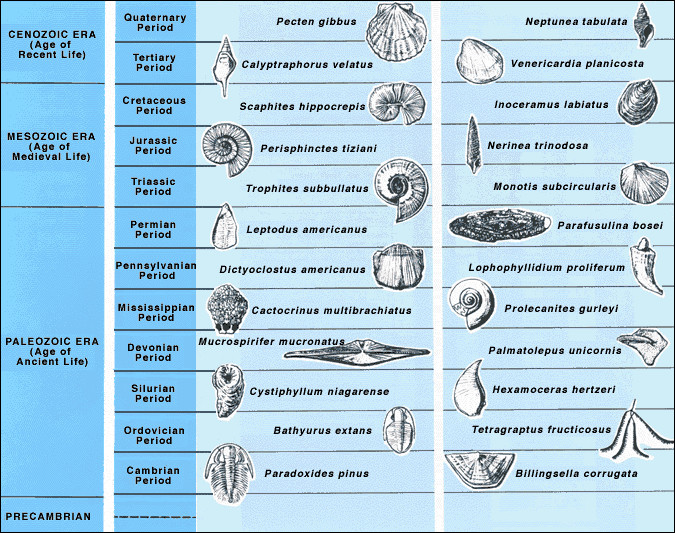 Index Fossils
Index Fossils
Alt text: Index fossils for biostratigraphic correlation, showcasing identification of ages in the Geologic Time Scale.
Alt text: Biostratigraphic correlation example featuring Foraminifera, a microfossil with a hard shell.
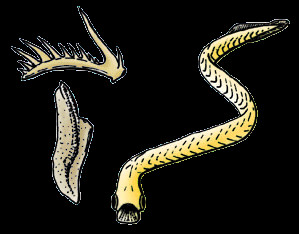 Euconodonta
Euconodonta
Alt text: Artist’s reconstruction of conodont animal used in biostratigraphic correlation alongside its teeth structures.
7. How is the Geologic Time Scale Used in Rock Layer Correlation?
The geologic time scale, developed during the 19th century, is subdivided into eons, eras, periods, epochs, and ages. The relative order of these time units was determined before geologists could assign numerical ages. Biostratigraphic correlation, using fossils, assigns era and period names to sedimentary rocks globally.
The geologic time scale’s divisions are consistent worldwide. However, rocks may or may not be present at a specific location, depending on the geological activity during a particular period. This leads to the concept of “time vs. rock,” where time is an unbroken continuum, but rocks may be missing or unavailable for study. The geologic time scale represents time flowing continuously from Earth’s beginning, with time units in an unbroken sequence, although not all time units have corresponding rocks available for study.
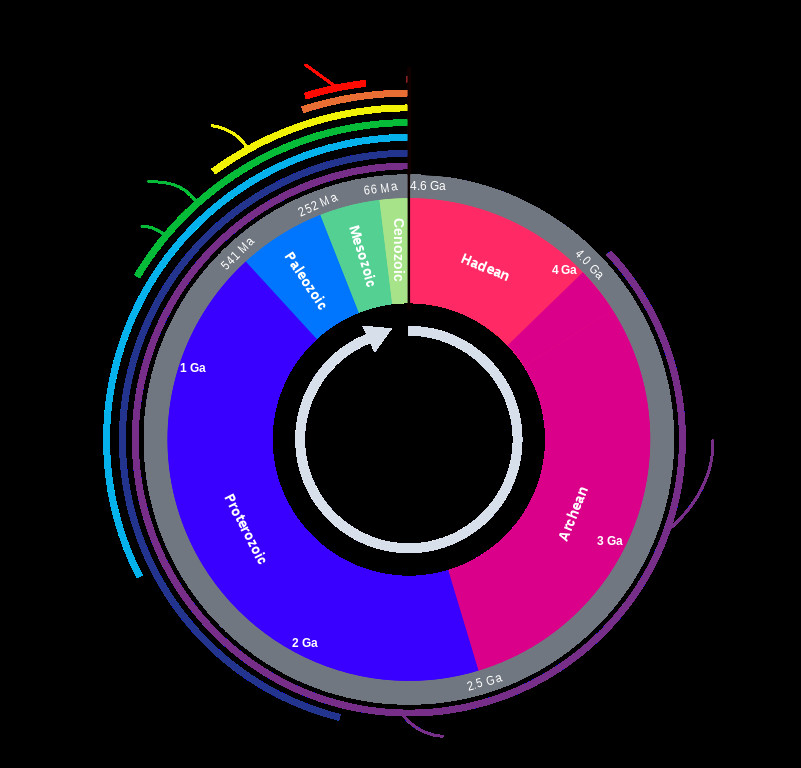 GeologicClock.png
GeologicClock.png
Alt text: The Geologic Time Scale represented circularly, showing individual time divisions and significant events.
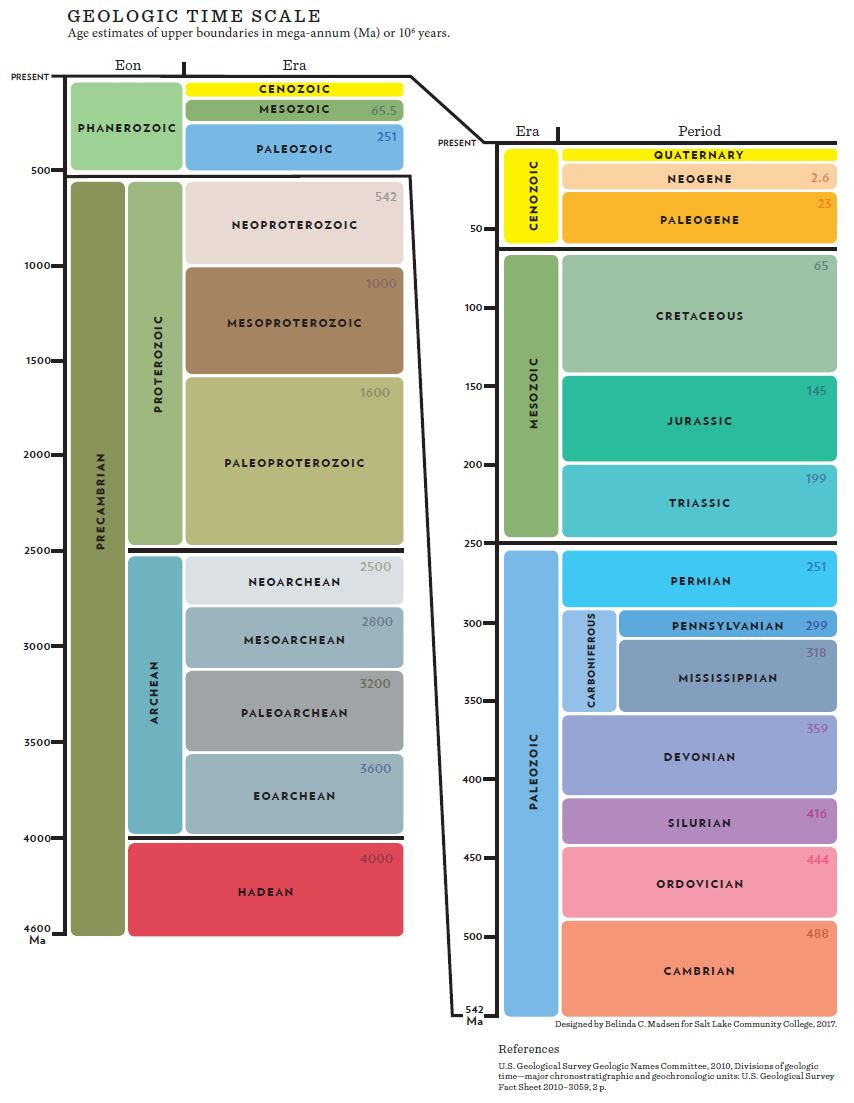 Geologic Time Scale with years
Geologic Time Scale with years
Alt text: Geologic Time Scale showcasing ages in millions of years ago.
8. What is the Anthropocene Epoch?
With the expansion of science and technology, some geologists propose a new geologic time period called the Anthropocene, recognizing humanity’s significant influence on natural processes. This epoch would mark a time when human activities have become a dominant geological force, leaving lasting impacts on the Earth’s systems.
9. How Does Magnetic Polarity Help in Correlating Rock Layers?
Magnetic polarity reversals, detailed in Chapter 2, provide another crucial method for correlating rock layers. As the Earth’s magnetic field reverses over time, these changes are recorded in rocks, offering a chronological marker that can be used to match strata across different regions.
10. What Are Some Additional Factors to Consider When Correlating Rock Layers?
Beyond the main methods, geologists also consider unique rock sequences and specific marker beds to correlate rock layers. A marker bed is a distinctive layer of rock that can be easily identified and traced over large areas. These can include volcanic ash layers, unique sedimentary deposits, or other geological features that provide a reliable point of reference for correlation.
11. How Can Rockscapes.net Help You Learn More About Rock Layer Correlation?
Rockscapes.net offers a wealth of information and resources for anyone interested in understanding rock layer correlation and the broader field of geology. Whether you’re a homeowner looking to enhance your landscape with unique rock features, a landscape designer seeking inspiration, or a student studying earth sciences, Rockscapes.net provides valuable insights and practical guidance. Explore our site to discover:
- Detailed guides on various rock types and their geological origins.
- Stunning examples of rockscapes from around the world.
- Expert advice on using rocks to create beautiful and sustainable landscapes.
12. What are Some Modern Applications of Rock Layer Correlation?
Rock layer correlation is not just an academic exercise; it has many practical applications in modern geology and environmental science. For example, it is used to:
- Locate natural resources: By understanding the stratigraphy of an area, geologists can predict where to find oil, gas, and mineral deposits.
- Assess environmental hazards: Correlating rock layers helps identify areas prone to landslides, earthquakes, and other geological hazards.
- Manage groundwater resources: Understanding the structure of subsurface rock layers is essential for managing and protecting groundwater resources.
- Reconstruct past climate change: By studying the fossils and sediments in correlated rock layers, scientists can reconstruct past climate conditions and understand how the Earth’s climate has changed over time.
13. How Does Climate Change Affect Rock Layer Correlation?
Climate change can impact rock layer correlation in several ways. For instance, changes in sea level can alter sedimentation patterns, making it more challenging to correlate rock layers based on lithology alone. Additionally, the distribution of certain index fossils may shift as species migrate in response to changing climate conditions, affecting biostratigraphic correlation.
14. What New Technologies are Used in Rock Layer Correlation?
Advancements in technology have significantly enhanced the accuracy and efficiency of rock layer correlation. Some of these technologies include:
- High-resolution satellite imagery: Provides detailed images of the Earth’s surface, allowing geologists to map rock formations and identify potential correlation sites.
- Geophysical surveys: Techniques such as seismic reflection and ground-penetrating radar provide subsurface data that can be used to correlate rock layers.
- Geochemical analysis: Analyzing the chemical composition of rocks can provide additional information for correlation, especially when lithological differences are subtle.
- Advanced dating methods: Radiometric dating techniques, such as uranium-lead dating and argon-argon dating, provide precise numerical ages for rock layers, improving the accuracy of chronostratigraphic correlation.
15. How Is Rock Layer Correlation Used in Archaeology?
Rock layer correlation is a valuable tool in archaeology for dating and understanding the context of archaeological sites. By correlating the rock layers in which artifacts are found with known geological formations, archaeologists can establish a timeline for human occupation and cultural development. This is particularly useful in areas with complex stratigraphy or where traditional dating methods are limited.
16. What Are The Challenges of Correlating Rock Layers in Tectonically Active Areas?
Correlating rock layers in tectonically active areas presents unique challenges due to the deformation and displacement of rock formations caused by faulting and folding. These geological processes can disrupt the original stratigraphic relationships, making it difficult to establish accurate correlations. Geologists must carefully analyze the structural geology of an area, using techniques such as fault mapping and cross-section construction, to reconstruct the original stratigraphy and correlate rock layers effectively.
17. How Is Rock Layer Correlation Used in Environmental Remediation?
Rock layer correlation plays a crucial role in environmental remediation projects by helping to characterize subsurface contamination. By understanding the stratigraphy of an area, environmental scientists can trace the movement of contaminants through different rock layers and identify potential pathways for exposure. This information is essential for designing effective remediation strategies and protecting human health and the environment.
18. How Can Non-Geologists Use Rock Layer Correlation in Their Own Backyards?
Even if you’re not a geologist, understanding basic principles of rock layer correlation can enhance your appreciation of the natural world and inform your landscaping decisions. By observing the types of rocks in your area and how they are arranged, you can gain insights into the geological history of your region. This knowledge can help you select appropriate materials for rock gardens, retaining walls, and other landscaping projects that complement the local geology.
19. What Are Some Common Misconceptions About Rock Layer Correlation?
There are several common misconceptions about rock layer correlation that can lead to misunderstandings. One misconception is that rock layers always represent continuous deposition over long periods of time. In reality, rock layers can be interrupted by periods of erosion or non-deposition, resulting in gaps in the geological record. Another misconception is that rock layers of the same lithology are always the same age. As we discussed earlier, different lithologies can form simultaneously in different depositional environments. It’s important to consider multiple lines of evidence, including stratigraphy, lithology, and biostratigraphy, to accurately correlate rock layers.
20. What are Some Examples of Famous Rock Layer Correlations Around the World?
There are many examples of famous rock layer correlations around the world that have contributed to our understanding of Earth’s history. One notable example is the correlation of the Permian-Triassic boundary, which marks a major extinction event in Earth’s history. By correlating rock layers across different continents, scientists have been able to reconstruct the environmental conditions that led to this extinction and understand its impact on life on Earth. Another example is the correlation of the Cretaceous-Paleogene boundary, which marks the extinction of the dinosaurs. This correlation has provided crucial evidence for the asteroid impact theory, which posits that a large asteroid struck Earth at the end of the Cretaceous period, leading to widespread environmental devastation and the extinction of many species.
Ready to explore the fascinating world of rock layer correlation and transform your landscape with beautiful, natural stone? Visit rockscapes.net today to discover a wide range of resources, including:
- Inspirational design ideas for creating stunning rockscapes.
- Detailed information on various types of rocks and their geological origins.
- Expert advice on selecting the right rocks for your project and ensuring their long-term durability.
Contact us at 1151 S Forest Ave, Tempe, AZ 85281, United States or call +1 (480) 965-9011 to speak with one of our knowledgeable team members. Let Rockscapes.net help you bring your vision to life with the timeless beauty of natural stone.
FAQ About How To Correlate Rock Layers
1. What is the primary goal of correlating rock layers?
The primary goal is to establish the age and relationships between geographically separated sedimentary strata by examining their stratigraphic position, lithology, fossil content, and magnetic properties.
2. What are the main types of stratigraphic correlation?
The main types are stratigraphic, lithostratigraphic, chronostratigraphic, and biostratigraphic correlation, each using different criteria to match rock layers.
3. How does lithostratigraphic correlation differ from chronostratigraphic correlation?
Lithostratigraphic correlation relies on similarities in rock composition and physical properties, while chronostratigraphic correlation focuses on matching rocks of the same age, even if their lithology differs.
4. What are index fossils and why are they important in biostratigraphic correlation?
Index fossils are fossils of organisms that lived during specific, well-defined periods of geologic time and were geographically widespread. They help assign absolute date ranges to rock formations.
5. Can magnetic polarity reversals be used to correlate rock layers?
Yes, magnetic polarity reversals recorded in rocks provide a chronological marker that can be used to match strata across different regions.
6. How does the geologic time scale relate to rock layer correlation?
The geologic time scale provides a framework for understanding the age and sequence of rock layers, with divisions like eons, eras, periods, and epochs used to correlate rocks worldwide.
7. What role do microfossils play in biostratigraphic correlation?
Microfossils, such as foraminifera and conodonts, are widely distributed and abundant, making them excellent index fossils for correlating strata, particularly in marine environments.
8. How do transgressions and regressions affect the formation of rock layers?
Transgressions (rising sea levels) lead to onlapping sediments, while regressions (falling sea levels) result in off-lapping sediments, creating different lithologies at varying depths.
9. What is the Anthropocene, and how does it relate to the geologic time scale?
The Anthropocene is a proposed new geologic epoch recognizing humanity’s significant impact on Earth’s natural processes, potentially marking a new division in the geologic time scale.
10. Where can I find more information and resources about rock layer correlation?
rockscapes.net offers detailed guides, inspirational design ideas, and expert advice on using rocks in landscapes, providing valuable insights for both homeowners and professionals interested in geology and landscape design.
